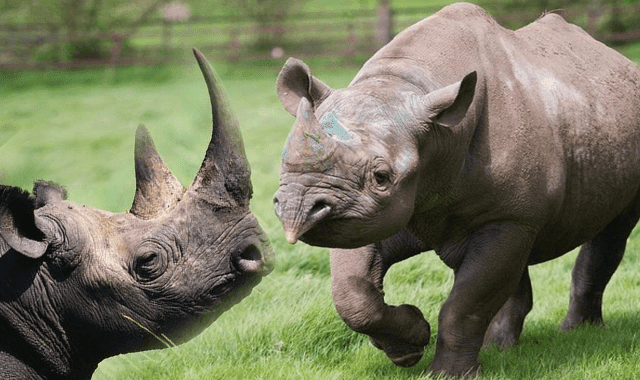 |
| Important secrets about the strongest animal white rhinoceros |
Rhino :
The rhino belongs to the class of mammals, the rank of the finger strings, and it is a very large and powerful animal, the five species of which were previously spread in Asia and South Africa, but these species are currently threatened with extinction. The rhinoceros is distinguished by its thick and strong skin, and its nose which has a horn or two horns, and has strong and short legs, and wide feet consisting of three huge fingers, a herbivorous animal that is active at night, and in the early morning hours, but during the daytime it is preferable to lie in the shadows, and it has my sense He smelled and heard well, but his ability to see is weak.General information about rhinoceros :
Here is some general information about rhinoceros :
- All kinds of rhinos resort to soaking in clay or dust to cool their skin and protect it from sunburn and insect bites; Some may think that the skin of a thick rhino is impervious, but it is allergic and is constantly exposed to scars. This is due to the presence of blood vessels near the surface of the skin.
- The rhino can move each ear in isolation from the other, directing one towards the front, while the second ear is facing backward, and it can extend its ears in the same direction when the need to focus.
- The unicorn in English "Rhinoceros" derives from two Greek words: the first word "Rhino" means nose, and the word "ceros" means horn.
- The black rhinoceros horn is the longest of all rhinoceros species; As it reaches 1.3 meters in length, and the horn of a unicorn differs from the centuries of other mammals in that it does not have a bone core inside, and is somewhat soft from the outside, and is subject to wear, and it grows again when it is broken.
- Oxpecker has a mutually beneficial relationship. The birds feed on the parasites on their skin and ears, and in return, warn them by screaming when they feel the approaching predators.
- The weight of a small unicorn at birth ranges between (40 - 64) kilograms, and it is able to stand on its feet after a short period of its birth, and begins eating solid food after the passage of (7-10) days, but it continues to feed until it reaches its age between (12-18) months, and the mother takes care of her young for a period of four years unless she becomes pregnant again.
- The period of pregnancy for a female rhinoceros lasts between (15-16) months, after which one small calf is born, or two in rare cases.
A rhinoceros, commonly abbreviated to rhino, is one of any five extant species of odd-toed ungulates in the family Rhinocerotidae, as well as any of the numerous extinct species therein. Two of the extant species are native to Africa, and three to Southern Asia.
Rhinoceros types :
There are five types of rhinoceros :
White rhino : White rhino is scientifically known as Ceratotherium simum, and its skin color is gray and not white as its name suggests, and it lives in Africa, specifically in South Africa, Zimbabwe, Swaziland, Tanzania, Uganda, Botswana, Namibia And Kenya, its weight ranges between (1800 - 2700) kg. The average age of a white rhinoceros in the wild is between (35-45) years, and it may sometimes reach fifty years, and its numbers in the wild have increased to (20,170) individuals, but it is still subject to poaching.Black rhino: The black rhino is scientifically known as Diceros bicornis, the color of its skin is gray, and it lives in Africa, and its weight ranges between (800 - 1350) kilograms, and it lives between (30-40) years, which is An introverted, shy, and more aggressive animal than a white rhino. The numbers of black rhinoceroses decreased from (65,000) individuals in the year (1970) to less than (5000) individuals, and it is currently spreading in Namibia, South Africa, Kenya, Tanzania, and Zimbabwe.
Greater One Horned Rhino: Indian rhino is scientifically known as Rhinoceros unicornis. At the beginning of the nineties of the last century, the numbers of the Indian rhinoceros did not exceed two hundred, but thanks to the efforts made to protect and breed the endangered species, there are currently 3333 individuals in the wet grasslands of India and Nepal. The weight of the Indian rhinoceros ranges between (1800 - 2700) kilograms, and lives in the wild between 40-50 years.
Sumatran rhino : A Sumatran rhino is scientifically known as Diceohinus sumatrensis, it is the smallest species of rhinoceros still alive, and is highly threatened with extinction; As there are only 100 of them spread in both Indonesia and Malaysia, due to the increasing demand for its horns, the destruction of its natural habitats, and its weight ranges between (600 - 950) kilograms, and lives in the wild between (30-45) years.
Javan Rhino : Java rhinos are scientifically known as Rhinoceros sondaicus; It is the most endangered species of rhino. As its numbers do not exceed (50) individuals who currently live in Ujung Kowloon National Park in Indonesia.
The female rhinoceros of Java are distinguished by the absence of horns on their nose, while the males possess one horn, as it is characterized by the presence of a lengthy upper lip that enables him to pick up the leaves and branches of trees, and he can also graze the grass, and its weight ranges between (900 - 2300) kilograms, and lives Between (30-45) years.

Comments
Post a Comment